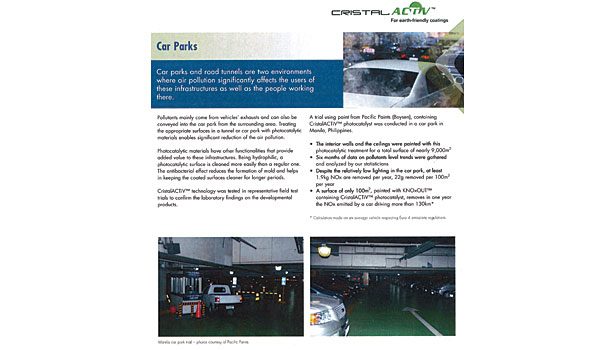A Powerful Ingredient at the Heart of “Green” Transformation






The transformation this has brought to the industry is akin to regular telephones turning into smart phones – phones that may no longer be used for making calls as their primary function. It warrants the question: “Will there be a time when coatings can be used to primarily create additional benefits, such as de-polluting and disinfecting the air – or even removing unpleasant odors?” Believe it or not – all these functions and more are already achievable with a new photocatalytic range of CristalACTiV™ materials. Now it’s simply a question of time.
This photocatalytic technology is a result of research and development at TiO2 manufacturer Cristal. The company developed catalysts used in systems to control air pollution “at source” such as stationary NOx abatement technology for power plants and diesel vehicles. By leveraging its role in the titanium dioxide pigment industry, as well as its experience in de-polluting solutions “at source,” Cristal has developed the next level of innovative ultrafine TiO2 applications to control atmospheric pollution. These materials enable paint formulators to address current pressures that businesses, regulators and consumers alike face to meet existing and future environmental regulations.
Stable, Nontoxic and Easy to Blend
CristalACTiV™ is an active, non-pigmenting and odorless photocatalyst that can be added to paint or building materials and is derived from naturally occurring titanium, which is the ninth most abundant element on earth. The solution can be formulated into stable, non-toxic and user-friendly paint systems, or it can be used on its own or added in powder form to many standard construction products.
Formulations can be created to enhance coatings to create a premium range of environmentally friendly, long-lasting and self-cleaning materials. CristalACTiV™ solution can achieve the following:
• Improvement of local air quality: CristalACTiV™-treated surfaces will draw dramatic volumes of NOx out of the air, effectively “eating pollution”. NOx reductions that can be achieved are as large as 60% NO and 20% NO2 in the immediate vicinity of the treated external surface, depending on conditions such as intensity of UV light, and wind direction and speed.
• Self-cleaning properties: This technology is self-cleaning and long lasting (up to 15 years depending on the application). The TiO2 photocatalyst is not consumed in the reaction; the duration of its effect depends on the service-life of the system wherein the TiO2 is used. This effect results from the reaction on the treated surface where the soiling material is broken down and then washed away either mechanically or by rainwater, leaving the surface clean.
• Cost-saving benefits: Given that CristalACTiV™ introduces self-cleaning properties to coatings, it offers significant savings on maintenance costs over time – as the surface does not need to be re-painted as frequently – in addition to improving local air quality.
How It Works
Ultrafine TiO2 CristalACTiV™ particles use UV energy from the sun or artificial light to break down pollution. The molecular photocatalytic chemical reaction happens at the molecular level when polluting substances come into contact with a treated surface. The combination of a tiny amount of water, sunlight and CristalACTiV™ breaks the molecular bonds of sulfur oxides, nitrogen oxides, VOCs and other substances produced during combustion or that are released in the atmosphere(Figure 1, page 48). Artificial and reflected light are enough to drive the reaction as well, which means that the solution works well in low-light, enclosed locations like car parks and road tunnels that have inherent exposure to air pollution.
Research shows that photocatalytic surfaces, either outdoor or indoor, can significantly decrease the pollutants present in the air, reducing the negative effects that those compounds have on health. The self-cleaning performance of photocatalytic surfaces contributes to reduce the maintenance costs (cleaning, repainting, etc.), while photodegradation of pollutants also results in cost savings (lower energy demand for air recirculation in polluted areas, such as car parks). Cristal developed and patented proprietary coating formulations to enhance the performance of CristalACTiV™ TiO2 photocatalysts.
Photocatalytic Powders
These products are manufactured to offer a range of surface morphologies and particle size distributions. Cristal-ACTiV™ photocatalytic TiO2 in powder form can be suitably formulated and incorporated into exterior coatings, building and construction materials, and transportation infrastructure products for roads, pavings and noise barriers. Photocatalytic functionality as described above can also be beneficial in many other applications such as plastics, textiles, roof tiles, etc.
Photocatalytic Sols
Three stable aqueous colloidal dispersions of ultrafine TiO2 are available, stabilized with acid or base. These sols can either be introduced as components of photocatalytic formulations to achieve an optimal dispersion of the ultrafine TiO2 particles or used to apply ultrafine TiO2 particles onto a surface in order to render it photocatalytic.
Case Studies
A number of trials confirm CristalACTiV’s™ properties. It has been confirmed that every 6 m2 of external surface, covered or treated with CristalACTiV™ – equivalent to an average passenger car – will, on average, remove NOx emissions of one Euro 4 car (diesel or petrol/gasoline) per day, (assuming that an average car travels 12 miles/20 km and emits 3.3 g of NOx per day.)
Separate CristalACTiV™ product trials in Manila, Philippines, conducted from 2009 to 2010, and a four-year trial of the product in Camden by Kings College London, have also confirmed this data. A typical UK semi-detached house with some 80 m2 of external walls, painted with the solution, could neutralize more than 13 cars worth of NOx emissions per day; a two-car household could remove more car-generated air pollutants than it causes.
Conclusion
This innovative solution enables air purification and a cleaner, lower-maintenance surface. It is a clear, high-tech solution to air pollution, as well as a number of other issues, and is achievable without any mandatory changes to our lifestyles and habits. It is only marginally more expensive that ordinary paint – but is cost neutral due to the solution’s self-cleaning properties. It is difficult to quantify the benefits of CristalACTiV™. How does one quantify better air quality and a potentially smaller number of asthma cases? Once the air pollution regulation comes into effect in major European cities, a clear choice will have to be made: either drastically reduce personal car use or embrace a solution like CristalACTiV™.
For more information, visit www.cristalactiv.com.
Looking for a reprint of this article?
From high-res PDFs to custom plaques, order your copy today!











